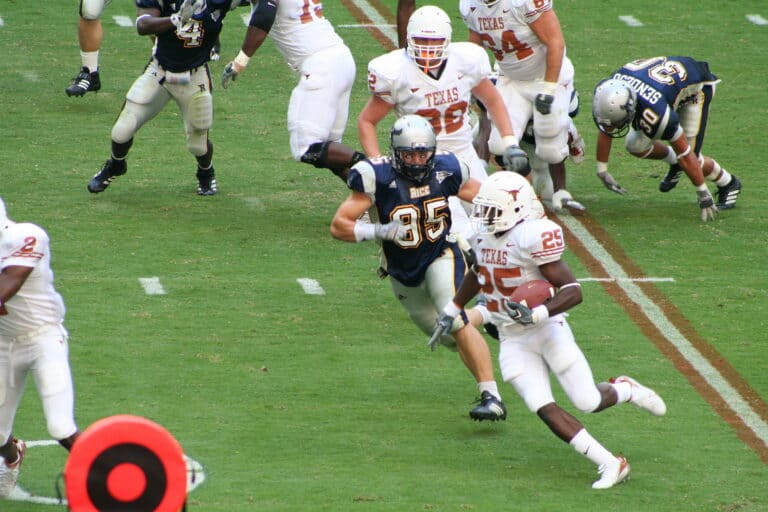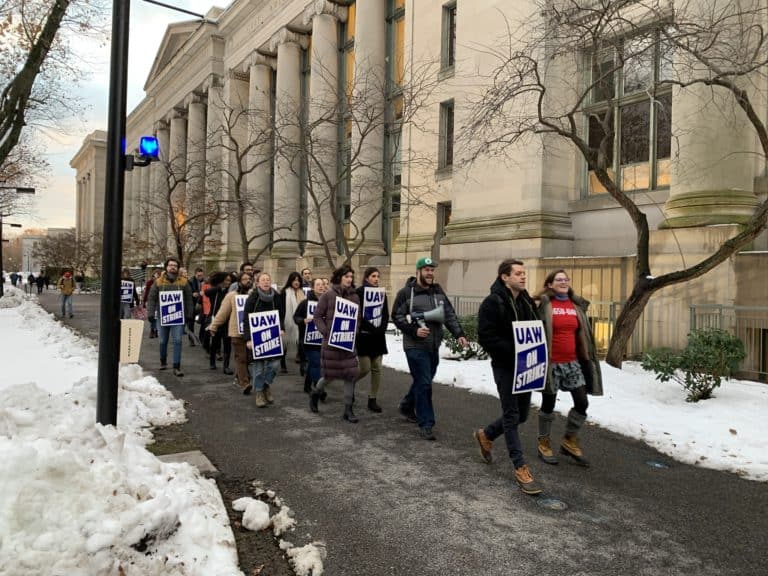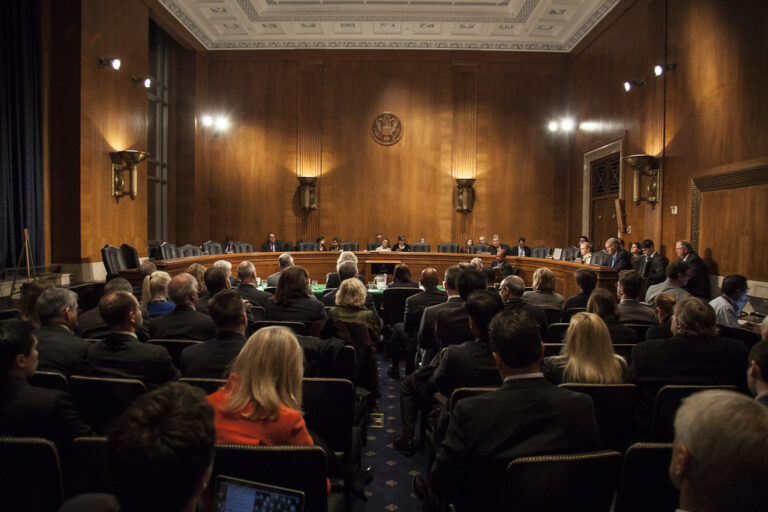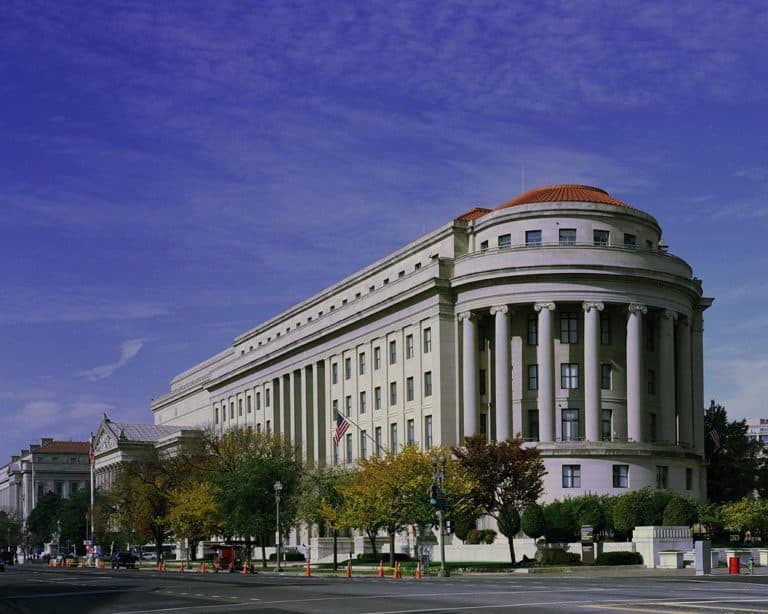
Charlotte Garden is the Julius E. Davis Professor of Law at the University of Minnesota Law School. She is a co-author of casebooks in Labor Law (with Richard Griffin, Joe Slater, and Anne Marie Lofaso), and Employment Law (with Mark Rothstein, Lance Liebman, Kimberly Yuracko and Paul Secunda). Professor Garden’s scholarly articles have appeared in the University of Pennsylvania Law Review, Emory Law Journal, Boston University Law Review, George Washington Law Review, Fordham Law Review, and the William & Mary Law Review. In 2019, Cambridge University Press published Professor Garden’s co-edited volume Cambridge Handbook on American Labor Law: Reviving American Labor for a 21st Century Economy (with Richard Bales).
I often criticize the Trump NLRB for taking too narrow a view of workers’ rights, creating an inevitable clash with First Amendment principles. But recently, I’ve had the opposite complaint: the Board and its General Counsel have been taking too broad a view of the First Amendment, suggesting that workers’ collective action or collective bargaining might interfere with employers’ own speech. Based on this reasoning, both have taken (or have signaled that they will take) action to deny employees the ability to engage in collective bargaining or other protected concerted activity.
The first example comes from the Board’s proposal to exclude graduate students at private universities from NLRA protection. (n.b., there is still time – until December 16 – to submit a comment on the proposed rule.) That rulemaking mainly focuses on the Board’s perception that graduate students do not have an “economic” relationship to their university. But then, the Board shifts focus:
Finally, [the Board’s proposed rule] advances the important policy of protecting traditional academic freedoms. These freedoms include both free speech rights in the classroom and several matters traditionally in the domain of academic decision-making, including those concerning course content and length; class size and location; who, what, and where to teach or research; university student assistant’ educational and service responsibilities; and standards for advancement and graduation. . . . Indeed, the nature of the general duty to bargain under the Act uniquely imperils the protection of academic freedoms. [Citations omitted.]
The Board does not cite the First Amendment directly anywhere in this proposed rulemaking, but it alludes to it twice: first, with its reference to “free speech” in the paragraph quoted above; and second, by citing Justice Frankfurter’s concurrence in Sweezy v. New Hampshire in support of its assertions about the scope of academic freedom. In Sweezy, the Court invalidated a contempt finding against a professor who refused to answer questions about his political beliefs and the content of his lectures; Justice Frankfurter concurred to emphasize the First Amendment issues in the case and the role of universities in a democratic society.
The second recent example of First Amendment overreach at the NLRB involves two memos from the Board’s general counsel. Each indicates that the GC’s office has declined to pursue unfair labor practice charges filed against a presidential campaign – the Sanders and Warren campaigns, respectively – in part because “the prosecution of a presidential election committee, which is so entwined with political speech protected by the constitution, could raise serious First Amendment considerations.” (The letters also cite campaigns’ “minimal impact on interstate commerce” and “unique and finite nature.” As to the last of these concerns, I note that some campaigns run for years; for example, the Trump 2020 campaign launched in early 2018, 980 days before the 2020 election.)
In other words, both the General Counsel and the Board itself seem to think that requiring employers to comply generally with labor law raises First Amendment questions, at least in the context of universities, and presidential campaigns – situations where the employers are also what the legal scholar Paul Horwitz might call “First Amendment institutions.” But neither the Board nor the GC explained their reasoning, so we are left to conjecture what their First Amendment concerns might be, and how far they might run. It is possible that they view these two situations as special contexts, or that their First Amendment arguments were intended only as additional support for the decisions instead of independent bases for them. But it is also possible that this reasoning will creep into new contexts; for example, at Vox, Ian Millhiser raised the alarm that the Board’s and the GC’s reasoning could extend to journalists’ concerted activity.
It is likely that, if pressed, the Board or the GC would say that they are simply interpreting the NLRA to avoid encroaching even a little bit on the First Amendment’s borders. But, as I have argued at greater length elsewhere, the justifications for “constitutional avoidance” do not stand up where: 1) the issue is presented in an as-applied challenge, so that there is no risk of facial invalidation of the NLRA; 2) the constitutional question to be avoided is insubstantial, but avoiding it would mean truncating employees’ statutory rights to engage in speech and association. These conditions are present in the situations described above.
On the seriousness of the First Amendment questions presented, the closest caselaw analogy comes from the press context. The Supreme Court held in Associated Press v. NLRB that application of the NLRA to a wire service did not violate the First Amendment. Of course, Associated Press is a 1937 decision that predates recent developments in First Amendment law – but those developments have not undermined the basic conclusion that there is no First Amendment exemption from generally applicable work laws for employers whose business is speech. In short, Associated Press is still good law.
On the other hand, there are a few examples of courts considering as-applied First Amendment challenges to the application of labor law in the contexts of particular labor disputes. For example, in Ampersand Publishing v. NLRB, the DC Circuit held that, for a combination of First Amendment and statutory reasons, journalists lost NLRA protection when their collective action was aimed at influencing their paper’s editorial policies. One could certainly disagree with that decision, but the important point for now is that it was narrow, focusing on the specific nature of the employees’ demands: were they demanding editorial control, or better economic treatment? Then, in a later iteration of the same case, the DC Circuit emphasized that newspapers do not have a blanket First Amendment exemption from labor law, and that papers’ First Amendment rights are not infringed when journalists seek to bargain collectively over economic issues.
Even if one agrees with the DC Circuit that labor law does not protect journalists’ concerted demands for changes to editorial policy, that Court’s approach differs from the Board’s current approach in an important way. The DC Circuit preserved employees’ NLRA rights to the extent possible, consistent with its view of the First Amendment. In contrast, the positions described above would cut a much broader swath, sacrificing employees’ own (statutory) rights to engage in speech and association in order vindicate a vision of First Amendment-mandated employer control that has been rejected by the courts.
Finally, one can’t help but compare the Board’s or GC’s approach in these documents to their approach in cases concerning arguable union secondary picketing. As readers of this blog will likely know, the NLRA contains limits on union protest aimed at influencing the behavior of entities other than those with which they have labor disputes. This protest often involves speech, such as picketing, or the use of inflatable rats or large banners that read “unfair” or “labor dispute” – creating an obvious potential for conflict between labor law and the First Amendment. During the Obama administration, the NLRB saw avoiding First Amendment questions as one reason (though not the only one) to interpret the statute’s secondary activity provision narrowly. For example, the Obama Board held that unions could use stationary banners and inflatable rats without violating the statute.
Given the Trump Board’s approach to avoiding First Amendment questions in the decisions described above, one might expect that it would continue the Obama Board’s approach to secondary activity. Instead, the opposite is true. For example, in Preferred Building Services, the NLRB evinced no concern for First Amendment “breathing space,” instead interpreting the requirements for lawful “common situs” picketing very rigidly – despite the obvious free speech interests at stake in that case, which involved consumer-facing picketing that relied on moral persuasion. Similarly, the General Counsel’s war on Scabby the Rat also raises serious First Amendment questions – but the GC office’s answer to those questions has been that “in the sphere of labor relations, the government has a substantial interest in justifying some restraints on First Amendment freedoms.” Taking all these cases together, the Trump Board’s approach to the First Amendment is actually quite straightforward: workers always lose.






Daily News & Commentary
Start your day with our roundup of the latest labor developments. See all
November 23
Workers at the Southeastern Pennsylvania Transportation Authority vote to authorize a strike; Washington State legislators consider a bill empowering public employees to bargain over workplace AI implementation; and University of California workers engage in a two-day strike.
November 21
The “Big Three” record labels make a deal with an AI music streaming startup; 30 stores join the now week-old Starbucks Workers United strike; and the Mine Safety and Health Administration draws scrutiny over a recent worker death.
November 20
Law professors file brief in Slaughter; New York appeals court hears arguments about blog post firing; Senate committee delays consideration of NLRB nominee.
November 19
A federal judge blocks the Trump administration’s efforts to cancel the collective bargaining rights of workers at the U.S. Agency for Global Media; Representative Jared Golden secures 218 signatures for a bill that would repeal a Trump administration executive order stripping federal workers of their collective bargaining rights; and Dallas residents sue the City of Dallas in hopes of declaring hundreds of ordinances that ban bias against LGBTQ+ individuals void.
November 18
A federal judge pressed DOJ lawyers to define “illegal” DEI programs; Peco Foods prevails in ERISA challenge over 401(k) forfeitures; D.C. court restores collective bargaining rights for Voice of America workers; Rep. Jared Golden secures House vote on restoring federal workers' union rights.
November 17
Justices receive petition to resolve FLSA circuit split, vaccine religious discrimination plaintiffs lose ground, and NJ sues Amazon over misclassification.